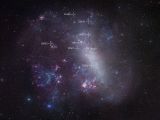There are plenty of challenges in understanding the universe, beginning with the most basic traits, such as distance. Since we can't actually go out and measure distances between things, we have to rely on other ways of determining how far something, a star or a galaxy, is.
One simple way of knowing how far a star is, for example, is to see how bright it is, the closer it is to us the brighter it will seem.
But there are plenty of other factors involved; the bigger the star, the brighter it will seem as well. If you know the precise size of a star though and its exact makeup, you can use its brightness to measure distances.
In fact, that's the way distances to the farthest galaxies are measured, by looking at the light from Type Ia supernovae, dubbed "standard candles."
All Type Ia supernovae have the exact same mass when they blow up, meaning their brightness will vary only by distance. A dim Type Ia supernova is far away, a bright one is close.
That's great for determining relative distances, i.e. to know whether one supernova is farther away than another, but not for determining how far it is from Earth.
Now, though, researchers have used another method to determine the distance to one of our closest galactic neighbors, the Large Magellanic Cloud (LMC), with unprecedented accuracy.
Using data gathered from ESO telescopes, astronomers have studied eight binary stars that share some unique properties. In doing so, they've managed to determine that the LMC is 163,000 light-years away within a 2 percent margin of error.
Measuring anything so far away so accurately is an achievement in itself, but it's more important than that, astronomers can now use this measurement to improve all other distance estimates in the universe.
Distances in the universe are always measured in relation to each other, so an improvement in one measurement will have a domino effect on all the other.
It's even better than that, a measurement so accurate will enable astronomers to get a much better idea of how fast the universe is expanding.
The team was trying to find signs of dark matter lumps. It didn't manage to, but observing 35 million stars for two decades has other benefits.
They focused on half a dozen binary pairs, stars that orbit each other. As these stars pass in front of each other, the amount of light originating from that point drops.
However, it drops by a different amount depending on which one is in front and how different they are in size.
This difference in brightness, along with their relative motion, can be used to measure their mass. With the mass known, the distance can be found.
But the method has some drawbacks as it requires a bit of guesswork. The team though eliminated this problem by focusing on old stars, which are past their hydrogen burning phase are now fueled mostly by helium.
For these, the mass can be much better determined from their color and brightness. This leads to much better distance measurements, which is how the astronomers were able to get such accurate results.

 14 DAY TRIAL //
14 DAY TRIAL // 
